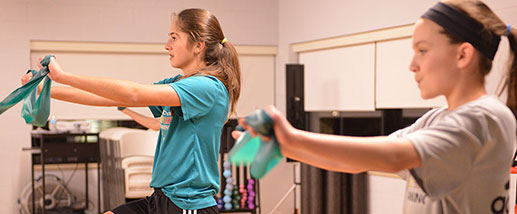ACL Tears Are Treatable and So Are Other Orthopedic Conditions
March 4, 2018Categories: Orthopedics (Bones, Joints, Muscles)
Many health-conscious Americans are on a quest to lead a more active lifestyle by participating in sports to be healthier and hopefully ward off disease and injury. At times, the body breaks down due to this increased activity and injuries occur.
Anterior cruciate ligament (ACL) injuries are one of the most common injuries among athletes. According to the American Orthopaedic Society for Sports Medicine, about 150,000 ACL injuries occur in the United States every year.
The ACL is important for maintaining the stability in the knee, particularly in activities involving cutting, pivoting or kicking. The ACL is one of four major ligaments (ligaments connect bone to bone) that coordinate function and promote stability of the knee joint. ACL injuries are usually non-contact injuries that occur most commonly in sports such as basketball, soccer, football, downhill skiing and tennis.
According to Shivajee Nallamothu, DO, a St. Joe’s orthopedic surgeon, ACL injuries include a sprain or tear of the ACL and typically occur from a direct blow to the knee when it is hyperextended or bent slightly inward, often during a sport such as football.
Symptoms may include:
- An audible pop at a moment of injury
- A knee that tends to slip out of joint, feeling unstable, and swelling and pain that hinders movement
- A knee that often feels as though it will give way or is unstable
Your doctor may conduct physical tests and take X-rays to determine the extent of damage to your ACL.
One-third of people with a completely torn ACL are able to build their muscle strength through therapy to resume normal activities without surgery. However, many patients with a torn ACL will eventually develop a torn meniscus—a protective cartilage that reduces friction between the knee bones—which may predispose them to the early onset of arthritis.
Active, athletic people are more likely to opt for surgery so that the knee can be repaired and rehabilitated and they can return to their activities.
“The surgery is called an endoscopic ACL reconstruction and involves replacing the torn ligament with one that may be taken from part of the patellar tendon—the patellar tendon attaches the bottom of the kneecap (patella) to the top of the shinbone (tibia)—from part of the hamstring tendon in the back of the knee, or it may be a donor,” explains Dr. Nallamothu.
Surgery is done either on an outpatient basis or an overnight stay in the hospital. After four to six months, you should be able to return to unrestricted activity and competitive sports.



